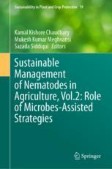Search
Search Results
-
Linking the protease activity to the nematicidal action of edible mushroom
Biological control using edible mushrooms as natural enemies is a sustainable alternative for pest management. Despite the well-established...

-
Nematicidal Activity of Secondary Metabolites from Soil Microbes
Control of plant-parasitic nematodes (PPNs) has become a complex problem because of their potential for damage and the lack of chemical...
-
Nematicidal and ovicidal activity of environmentally-friendly selenol ester derivatives against Meloidogyne incognita
Nematodes from the genus Meloidogyne are extremely harmful to agricultural crops due to their wide geographic distribution, variety of hosts, and...

-
Nematicidal activity of volatile organic compounds produced by Bacillus altitudinis AMCC 1040 against Meloidogyne incognita
The application of nematicidal microorganisms and their virulence factors provides more opportunities to control root-knot nematodes. Bacillus...

-
Nematicidal phytochemicals against pine wood nematode, Bursaphelenchus xylophilus (nematoda: aphelenchoididae)
AS the major causative agent of pine wilt disease, pine wood nematode, Bursaphelenchus xylophilus can result in rapid and massive deaths of pine...

-
Screening of Endophytes for Nematicidal Activities
Endophytes are symbiotic microorganisms found in almost all living plant species and hold a very special place due to the fact that it colonizes in...
-
An In Vitro Nematicidal Activity of Actinobacteria: Juvenile Mortality and Egg Hatching Inhibition
Plant-parasitic nematodes are microscopic, obligatory endoparasites with worldwide distribution can cause severe damage to various agricultural...
-
Nematicidal lipopeptides from Bacillus paralicheniformis and Bacillus subtilis: A comparative study
AbstractThe aim of this work was to develop a comparative study between Bacillus paralicheniformis TB197 and B. subtilis ATCC 21332 strains in terms...

-
Abundance, distribution, and expression of nematicidal crystal protein genes in Bacillus thuringiensis strains from diverse habitats
Bacillus thuringiensis (Bt) is a Gram-positive bacterium that accumulates pesticidal proteins (Cry and Cyt) in parasporal crystals. Proteins from the...

-
Characterization and nematicidal potential of copper, iron and zinc nanoparticles synthesized from Tridax procumbens L. Extract on Meloidogyne incognita infected cabbage plants
Copper, iron and zinc nanoparticles (NPs) were synthesized with aqueous extract of Tridax procumbens. The NPs were characterized with UV–Vis,...

-
Synthetic chalcone 1-(4-Fluoro-phenyl)-3-phenyl-propenone with high nematicidal potential against the root-knot nematode Meloidogyne incognita
Plant-parasitic nematodes pose a major threat to crop production where root-knot nematode Meloidogyne incognita is a serious threat. In spite of...

-
Assessment of Nematicidal Activity of Microbial Volatiles
Plant-parasitic nematodes are causing severe damage to the agricultural crops. Obligate root parasites such as root-knot nematodes infect more than...
-
A new strain of Volutella citrinella with nematode predation and nematicidal activity, isolated from the cysts of potato cyst nematodes in China
BackgroundPlant parasitic nematodes (PPNs) are responsible for causing many plant diseases and are extremely difficult to control at present....

-
The characterization of chitinolytic soil bacterial isolates for their antagonistic activity against root knot nematode Meloidogyne incognita: an effort towards develo** ‘green’ nematicidal agents
Root knot nematode ( Meloidogyne spp.) is one of the most infective nematode genera having a wide range of host plants. The study was aimed to isolate...

-
Identification of chemical components from essential oils and aqueous extracts of some medicinal plants and their nematicidal effects on Meloidogyne incognita
BackgroundEssential oils from aerial parts of Achillea wilhelmsii , Tanacetum polycephalum and Teucrium polium were isolated by using Clevenger-type...

-
In vitro nematicidal and acaricidal effect of biosurfactants produced by Bacillus against the root-knot nematode Nacobbus aberrans and the dust mite Tyrophagus putrescentiae
In the present study, the nematicidal and acaricidal activity of three biosurfactants (BS) produced by strains of the Bacillus genus was evaluated....

-
Ecofriendly synthesis and nematicidal application of copper nanoparticles fabricated from Bacillus subtilis AM18, against root-knot nematode of cucumber
The potential application of biological copper (Cu) nanoparticles (BCuNPs) as fungicides, insecticides, and fertilizers has piqued the interest of...

-
Nematicidal activity of Lagenandra toxicaria Dalz and Kaempferia rotunda L. rhizome extracts against root-knot nematode, Meloidogyne incognita (Kofoid and White) Chitwood and burrowing nematode, Radopholus similis Cobb
The plant parasitic pests such as the root-knot nematode Meloidogyne incognita and burrowing nematode, Radopholus similis are considered as...

-
Nematicidal effects of a peptidase (NlpC/P60) from the phytopathogen Pseudomonas syringae MB03 on the model nematode Caenorhabditis elegans and plant-parasitic Meloidogyne incognita
BackgroundPlant-parasitic nematodes (PPNs) are severe threats to agricultural yields and continue to be challenging to treat in several crops...

-
Nematicidal Property of Clindamycin and 5-hydroxy-2-methyl Furfural (HMF) from the Banana Endophyte Bacillus velezensis (YEBBR6) Against Banana Burrowing Nematode Radopholus similis
Radopholus similis is a burrowing nematode which causes banana toppling disease and is of major economic threat for the banana production. Bacterial...

